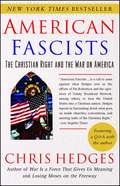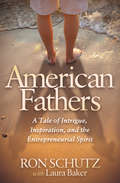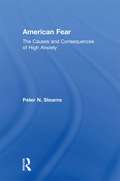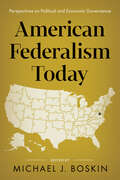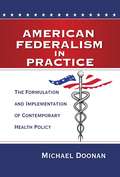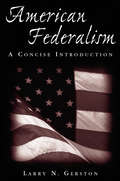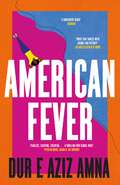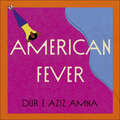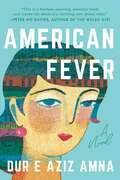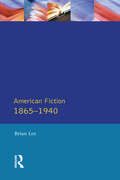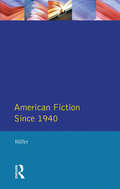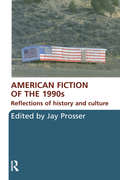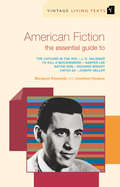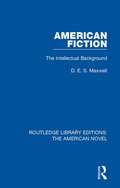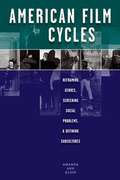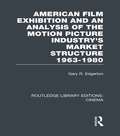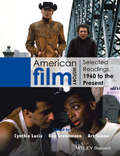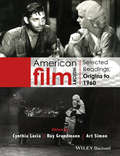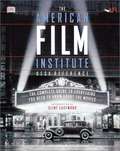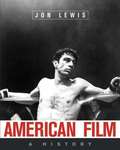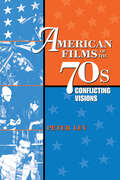- Table View
- List View
American Fascists: The Christian Right and the War On America
by Chris HedgesTwenty-five years ago, when Pat Robertson and other radio and televangelists first spoke of the United States becoming a Christian nation that would build a global Christian empire, it was hard to take such hyperbolic rhetoric seriously. Today, such language no longer sounds like hyperbole but poses, instead, a very real threat to our freedom and our way of life. In American Fascists, Chris Hedges, veteran journalist and author of the National Book Award finalist War Is a Force That Gives Us Meaning, challenges the Christian Right's religious legitimacy and argues that at its core it is a mass movement fueled by unbridled nationalism and a hatred for the open society. Hedges, who grew up in rural parishes in upstate New York where his father was a Presbyterian pastor, attacks the movement as someone steeped in the Bible and Christian tradition. He points to the hundreds of senators and members of Congress who have earned between 80 and 100 percent approval ratings from the three most influential Christian Right advocacy groups as one of many signs that the movement is burrowing deep inside the American government to subvert it. The movement's call to dismantle the wall between church and state and the intolerance it preaches against all who do not conform to its warped vision of a Christian America are pumped into tens of millions of American homes through Christian television and radio stations, as well as reinforced through the curriculum in Christian schools. The movement's yearning for apocalyptic violence and its assault on dispassionate, intellectual inquiry are laying the foundation for a new, frightening America. American Fascists, which includes interviews and coverage of events such as pro-life rallies and weeklong classes on conversion techniques, examines the movement's origins, its driving motivations and its dark ideological underpinnings. Hedges argues that the movement currently resembles the young fascist movements in Italy and Germany in the 1920s and '30s, movements that often masked the full extent of their drive for totalitarianism and were willing to make concessions until they achieved unrivaled power. The Christian Right, like these early fascist movements, does not openly call for dictatorship, nor does it use physical violence to suppress opposition. In short, the movement is not yet revolutionary. But the ideological architecture of a Christian fascism is being cemented in place. The movement has roused its followers to a fever pitch of despair and fury. All it will take, Hedges writes, is one more national crisis on the order of September 11 for the Christian Right to make a concerted drive to destroy American democracy. The movement awaits a crisis. At that moment they will reveal themselves for what they truly are -- the American heirs to fascism. Hedges issues a potent, impassioned warning. We face an imminent threat. His book reminds us of the dangers liberal, democratic societies face when they tolerate the intolerant.
American Fatherhood: A History
by Jürgen MartschukatExplores the surprising diversity of fathers and fatherhood throughout American history and society The nuclear family has been endlessly praised as the bedrock of American society, even though there has rarely been a time in history when a majority of Americans lived in such families. This book deconstructs the myth of the nuclear family by presenting the rich diversity of family lives in American history from the American Revolution to the twenty-first century. To tell this story, Jürgen Martschukat focuses on fathers and their relations to families and American society. Using biographical close-ups of twelve different characters, each embedded in historical context, American Fatherhood provides a much more realistic picture of how fatherhood has been performed within different kinds of families. Each protagonist covers a crucial period or event in American history, presents a different family constellation, and makes a different argument with regard to how American society is governed through the family.
American Fathers: A Tale of Intrigue, Inspiration, and the Entrepreneurial Spirit
by Ron Schutz Laura BakerAn inspirational modern-day fable about finding success, happiness and the American dream both in business and in life. A smart and level-headed recent college graduate, Sasha thinks he has a good grip on life—until everything goes haywire. His ideal family is shattered when his mom leaves and his dad re-marries. Even more unsettling, Sasha is forced to question his own identity when he starts receiving mysterious messages from a Russian agent claiming to be his biological father. Determined to make his own way, Sasha boldly starts his own business as his enigmatic new father-figure mentors him in the ways of capitalism, personal finance, and starting a new business based on an innovative idea. Follow Sasha on his spiritual journey to his own path among friends who are from different faiths. This fast-moving tale spins an unfolding mystery while offering practical tools for life and businesses.
American Fear: The Causes and Consequences of High Anxiety (Focal Digital Camera Guides)
by Peter N. StearnsAmericans have become excessively fearful, and manipulation through fear has become a significant problem in American society, with real impact on policy. By using data from 9/11, this book makes a distinctive contribution to the exploration of recent fear, but also by developing a historical perspective, the book shows how and why distinctive American fears have emerged over the past several decades.
American Federalism Today: Perspectives on Political and Economic Governance
by Michael J. BoskinWhat are federalism's challenges and opportunities today? The framers of the US Constitution enumerated specific powers for the federal government, leaving all else under the purview of states or the people. Over time, the federal government has expanded its role, yet the American people have more trust in state and local governments that are closer to them—and where co-partisanship is often a matter of necessity. Scholars and practitioners in policymaking gathered at the Hoover Institution in September 2023 to discuss the ramifications of federalism for contemporary issues. American Federalism Today presents those conference proceedings. Renowned experts from a range of disciplines, including economics, political science, history, and law, lay out the key priorities in evaluating and reinvigorating America's federal system of governance. Among the topics they examine are infrastructure, education and healthcare financing, trust in government, and intergovernmental relations in an era of rising federal debt and unfunded state and local liabilities. Three influential governors—Mitch Daniels, Jeb Bush, and Jerry Brown—describe navigating the federalist system as they led their states through many challenges. This unique compilation draws on the remarkable expertise and experience of its contributors to probe federalism's strengths, weaknesses, opportunities, and challenges in the nation's political and economic governance.
American Federalism in Practice
by Michael DoonanAmerican Federalism in Practice is an original and important contribution to our understanding of contemporary health policy. It also illustrates how contentious public policy is debated, formulated, and implemented in today's overheated political environment.Health care reform is perhaps the most divisive public policy issue facing the United States today. Michael Doonan provides a unique perspective on health policy in explaining how intergovernmental relations shape public policy. He tracks federal-state relations through the creation, formulation, and implementation of three of the most important health policy initiatives since the Great Society: the State Children's Health Insurance Program (CHIP) and the Health Insurance Portability and Accountability Act (HIPAA), both passed by the U.S. Congress, and the Massachusetts health care reform program as it was developed and implemented under federal government waiver authority. He applies lessons learned from these cases to implementation of the Affordable Care Act."Health policymaking is entangled in a complex web of shared, overlapping, and/or competing power relationships among different levels of government," the author notes. Understanding federal-state interactions, the ways in which they vary, and the reasons for such variation is essential to grasping the ultimate impact of federalism on programs and policy. Doonan reveals how federalism can shift as the sausage of public policy is made while providing a new framework for comprehending one of the most polarizing debates of our time.
American Federalism in Practice: The Formulation and Implementation of Contemporary Health Policy
by Michael Doonan"American Federalism in Practice" is a major contribution to our understanding of contemporary health policy in America. Always an important topic, the issue holds special currency today given the prominence of health care in todays political and economic landscape. Michael Doonan provides a unique perspective on American federalism and U. S. health policy in explaining how intergovernmental relations shape public policy in health as well as other critical areas. Doonan tracks federal-state relations through the creation, formulation, and implementation of three of the most important health policy initiatives since the Great Society: the Childrens Health Insurance Program (CHIP) and the Health Insurance Portability and Accountability Act (HIPAA), both developed in Congress, and the Massachusetts health care reform program as it was developed and implemented under federal government waiver authority. Massachusetts, though not without having to face challenges, actually succeeded in lowering its uninsured rate to below two percent. Success and failure of these three programs can be traced in large part to a balance between state flexibility and accountability to meet program goals. Achieving that balance is not easy, of course, but lessons learned from previous successes --and failures --in structuring intergovernmental relations offer unique insights into national health reform and contemporary public policy. Doonan reveals how federalism can shift as the sausage of public policy is made, providing a previously missing link between federalism theory and practice. His work should change the way people think about federalism in a policy context while providing a new and useful framework through which we can view, and hopefully comprehend, some of the most important and polarizing policy debates of our time.
American Federalism: A Concise Introduction
by Larry N. GerstonUnderstanding federalism - the form of political organization that unites separate polities within an overarching political system so that all maintain their political integrity - is central to the study of democratic government in the United States. Yet, many political scientists treat federalism as a set of abstract principles or a maze of budgetary transfers with little connection to real political life. This concise and engaging book boils the discussion down to its essence: federalism is about power, specifically the tug for power among and within the various levels of government. Author Larry N. Gerston examines the historical and philosophical underpinnings of federalism; the various "change events" that have been involved in defining America's unique set of federal principles over time; and the vertical, horizontal, and international dimensions of federalism in the United States today. The result is a book examining the ways in which institutional political power is both diffused and concentrated in the United States.
American Fever
by Dur e Amna'Unforgettable... Rarely does a book sharpen how you see the world around you, but American Fever does just that. It dazzled me on every page' Julie Buntin, author of MarlenaOn a year-long exchange programme in rural Oregon, sixteen-year-old Hira must swap Kashmiri chai for volleyball practice and understand why everyone around her seems to dislike Obama. An unforgettably witty narrator, Hira finds herself stuck between worlds. The experience is memorable for reasons both good and bad; a first kiss, new friends, racism, Islamophobia, homesickness. Along the way Hira starts to feel increasingly unwell until she begins coughing up blood, and receives a diagnosis of tuberculosis, pushing her into quarantine and turning her newly-established world upside down.'Marks the debut of a thrilling new global voice' Peter Ho Davies'In this sharply observed twist on the classic coming-to-America story, we find an America recognizable in all its generosity, cruelty, and sometimes-well-intentioned bumbling. And we find a brilliant exploration of the sacred, scary moment when a girl comes into the wider world' Benjamin Moser, Pulitzer-Prize-winning author of Sontag: Her Life and Work
American Fever
by Dur e Amna'Unforgettable... Rarely does a book sharpen how you see the world around you, but American Fever does just that. It dazzled me on every page' Julie Buntin, author of MarlenaOn a year-long exchange programme in rural Oregon, sixteen-year-old Hira must swap Kashmiri chai for volleyball practice and understand why everyone around her seems to dislike Obama. An unforgettably witty narrator, Hira finds herself stuck between worlds. The experience is memorable for reasons both good and bad; a first kiss, new friends, racism, Islamophobia, homesickness. Along the way Hira starts to feel increasingly unwell until she begins coughing up blood, and receives a diagnosis of tuberculosis, pushing her into quarantine and turning her newly-established world upside down.'Marks the debut of a thrilling new global voice' Peter Ho Davies'In this sharply observed twist on the classic coming-to-America story, we find an America recognizable in all its generosity, cruelty, and sometimes-well-intentioned bumbling. And we find a brilliant exploration of the sacred, scary moment when a girl comes into the wider world' Benjamin Moser, Pulitzer-Prize-winning author of Sontag: Her Life and Work
American Fever
by Dur e AmnaA deeply compelling and funny coming-of-age novel about a teenaged girl's life-changing journey from Pakistan to America, and the challenges of a debilitating illness.On a year-long exchange programme in rural Oregon, sixteen-year-old Hira must swap Kashmiri chai for volleyball practice and understand why everyone around her seems to dislike Obama. An unforgettably witty narrator, Hira finds herself stuck between worlds. The experience is memorable for reasons both good and bad; a first kiss, new friends, racism, Islamophobia, homesickness. Along the way Hira starts to feel increasingly unwell until she begins coughing up blood, and receives a diagnosis of tuberculosis, pushing her into quarantine and turning her newly-established world upside down.'Unforgettable... Rarely does a book sharpen how you see the world around you, but American Fever does just that.' Julie Buntin, author of Marlena'Marks the debut of a thrilling new global voice' Peter Ho Davies'In this sharply observed twist on the classic coming-to-America story, we find an America recognizable in all its generosity, cruelty, and sometimes-well-intentioned bumbling. And we find a brilliant exploration of the sacred, scary moment when a girl comes into the wider world' Benjamin Moser, Pulitzer-Prize-winning author of Sontag: Her Life and Work (P) 2022 Hodder & Stoughton Limited
American Fever: A Novel
by Dur e Aziz AmnaUSA Today Best books of August Christian Science Monitor Ten Best Books of August The Millions Most Anticipated Books of 2022 Harper's Bazaar Must-Read Books of August 2022 Debuts of the Season by Vogue India Bustle Most Anticipated Books of August 2022 "A funny and affecting novel...a wonderful new spin on the coming-of-age story. A smart, charming debut." (Kirkus, starred review) "A fascinating mix of immigrant tale, coming-of-age narrative, and cultural exposition...tackling some of the big migration questions of home and identity." (Booklist)&“This is a fearless, exacting, essential work, and marks the debut of a thrilling new global voice.&”—Peter Ho Davies, author of The Welsh Girl On a year-long exchange program in rural Oregon, a Pakistani student, sixteen-year-old Hira, must swap Kashmiri chai for volleyball practice and try to understand why everyone around her seems to dislike Obama. A skeptically witty narrator, Hira finds herself stuck between worlds. The experience is memorable for reasons both good and bad; a first kiss, new friends, racism, Islamophobia, homesickness. Along the way Hira starts to feel increasingly unwell until she begins coughing up blood, and receives a diagnosis of tuberculosis, pushing her into quarantine and turning her newly established home away from home upside down. American Fever is a compelling and laugh-out-loud funny novel about adolescence, family, otherness, religion, the push-and-pull of home. It marks the entrance on the international literary scene of the brilliant fresh voice of Dur e Aziz Amna.
American Fiction 1865 - 1940 (Longman Literature In English Series)
by Brian LeeBrian Lee's study of American fiction from 1865 to 1940 draws on a wealth of material by, amongst others, Twain, James, Dreiser, Hemingway, Fitzgerald and Faulkner. Though the works of these writers have been closely scrutinised by postwar critics in Europe and America, few attempts have yet been made to utilise the new critical approaches and theories in the service of literary history. Brian Lee does so in this book, relating the writers of the period - both major and minor - to its patterns of immense economic, social and intellectual change.
American Fiction Since 1940 (Longman Literature In English Series)
by Tony HilferIn this remarkable book, Tony Hilfer provides a major survey of the wealth of post-war American fiction. He analyses the major modes and genres of writing, from realist to postmodernist metafiction and black humour, the fiction of social protest, women's writing, and the traditions of African-American, Southern and Jewish-American fiction. Key writers discussed include William Faulkner, Norman Mailer, Ralph Ellison, Saul Bellow, Joseph Heller, Vladimir Nabokov and Joyce Carol Oates. The book concludes by exploring contemporary trends through detailed case-studies of Donald Barthelme and Toni Morrison.
American Fiction of the 1990s: Reflections of history and culture
by Jay ProsserAmerican Fiction of the 1990s: Reflections of History and Culture brings together essays from international experts to examine one of the most vital and energized decades in American literature. This volume reads the rich body of 1990s American fiction in the context of key cultural concerns of the period. The issues that the contributors identify as especially productive include: Immigration and America’s geographical borders, particularly those with Latin America Racial tensions, race relations and racial exchanges Historical memory and the recording of history Sex, scandal and the politicization of sexuality Postmodern technologies, terrorism and paranoia American Fiction of the 1990s examines texts by established authors such as Don DeLillo, Toni Morrison, Philip Roth and Thomas Pynchon, who write some of their most ambitious work in the period, but also by emergent writers, such as Sherman Alexie, Chang-Rae Lee, E. Annie Proulx, David Foster Wallace, and Jonathan Franzen. Offering new insight into both the literature and the culture of the period, as well as the interaction between the two in a way that furthers the New American Studies, this volume will be essential reading for students and lecturers of American literature and culture and late twentieth-century fiction. Contributors include: Timothy Aubry, Alex Blazer, Kasia Boddy, Stephen J. Burn, Andrew Dix, Brian Jarvis, Suzanne W. Jones, Peter Knight, A. Robert Lee, Stacey Olster, Derek Parker Royal, Krishna Sen, Zoe Trodd, Andrew Warnes and Nahem Yousaf.
American Fiction: The Essential Guide To (Vintage Living Texts #15)
by Margaret Reynolds Jonathan NoakesCatch 22, Cather in the Rye, To Kill a Mocking Bird and Native Son- this guide deals with the themes, genre and narrative techniques of these four classic American novels, with an emphasis on providing a rich source of ideas for intelligent and inventive ways of approaching the novels. Amongst many other features you'll find inpsirational reading plans and contextual material, suggested complementary and comparative reading and an indispensable glossary.
American Fiction: The Intellectual Background (Routledge Library Editions: The American Novel #11)
by D. E. MaxwellOriginally published in 1963. The ‘Americanness’ of the American novel is as readily apparent as it is elusive of definition. It is the purpose of this study not to discover the reluctant formula, the comprehensive statement of national identity, but to examine the evidences of this identity in the work of some individual American writers. This study explores the works of many prominent American authors including Edgar Allan Poe, Nathanial Hawthorne, and Mark Twain.
American Film Cycles
by Amanda Ann KleinA series of movies that share images, characters, settings, plots, or themes, film cycles have been an industrial strategy since the beginning of cinema. While some have viewed them as “subgenres,” mini-genres, or nascent film genres, Amanda Ann Klein argues that film cycles are an entity in their own right and a subject worthy of their own study. She posits that film cycles retain the marks of their historical, economic, and generic contexts and therefore can reveal much about the state of contemporary politics, prevalent social ideologies, aesthetic trends, popular desires, and anxieties. American Film Cycles presents a series of case studies of successful film cycles, including the melodramatic gangster films of the 1920s, the 1930s Dead End Kids cycle, the 1950s juvenile delinquent teenpic cycle, and the 1990s ghetto action cycle. Klein situates these films in several historical trajectories—the Progressive movement of the 1910s and 1920s, the beginnings of America’s involvement in World War II, the “birth” of the teenager in the 1950s, and the drug and gangbanger crises of the early 1990s. She shows how filmmakers, audiences, film reviewers, advertisements, and cultural discourses interact with and have an impact on the film texts. Her findings illustrate the utility of the film cycle in broadening our understanding of established film genres, articulating and building upon beliefs about contemporary social problems, shaping and disseminating deviant subcultures, and exploiting and reflecting upon racial and political upheaval.
American Film Exhibition and an Analysis of the Motion Picture Industry's Market Structure 1963-1980 (Routledge Library Editions: Cinema)
by Gary EdgertonThis study looks at how the movie industry organisation functioned between the late ‘40s and 1983 when it was originally published. It describes the changing role of domestic exhibition through this time and analyses the wider film industry to provide a model of the exhibition structure in relation to production, distribution and outside factors. It addresses the growing issues of the cable and video markets as competition to the film exhibition business at that time and looks forward into a highly turbulent environment. With particular interest now as the film industry address a new range of threats and adaptations of its working structure, this book offers and integral understanding of a key stage in cinema history.
American Film History: Selected Readings, 1960 to the Present
by Cynthia Lucia Roy Grundmann Art SimonFrom the American underground film to the blockbuster superhero, this authoritative collection of introductory and specialized readings explores the core issues and developments in American cinematic history during the second half of the twentieth-century through the present day. Considers essential subjects that have shaped the American film industry—from the impact of television and CGI to the rise of independent and underground film; from the impact of the civil rights, feminist and LGBT movements to that of 9/11. Features a student-friendly structure dividing coverage into the periods 1960-1975, 1976-1990, and 1991 to the present day, each of which opens with an historical overview Brings together a rich and varied selection of contributions by established film scholars, combining broad historical, social, and political contexts with detailed analysis of individual films, including Midnight Cowboy, Nashville, Cat Ballou, Chicago, Back to the Future, Killer of Sheep, Daughters of the Dust, Nothing But a Man, Ali, Easy Rider, The Conversation, The Texas Chain Saw Massacre, Longtime Companion, The Matrix, The War Tapes, the Batman films, and selected avant-garde and documentary films, among many others. Additional online resources, such as sample syllabi, which include suggested readings and filmographies, for both general and specialized courses, will be available online. May be used alongside American Film History: Selected Readings, Origins to 1960 to provide an authoritative study of American cinema from its earliest days through the new millennium
American Film History: Selected Readings, Origins to 1960
by Cynthia Lucia Roy Grundmann Art SimonThis authoritative collection of introductory and specialized readings explores the rich and innovative history of this period in American cinema. Spanning an essential range of subjects from the early 1900s Nickelodeon to the decline of the studio system in the 1960s, it combines a broad historical context with careful readings of individual films. Charts the rise of film in early twentieth-century America from its origins to 1960, exploring mainstream trends and developments, along with topics often relegated to the margins of standard film histories Covers diverse issues ranging from silent film and its iconic figures such as Charlie Chaplin, to the coming of sound and the rise of film genres, studio moguls, and, later, the Production Code and Cold War Blacklist Designed with both students and scholars in mind: each section opens with an historical overview and includes chapters that provide close, careful readings of individual films clustered around specific topics Accessibly structured by historical period, offering valuable cultural, social, and political contexts Contains careful, close analysis of key filmmakers and films from the era including D.W. Griffith, Charles Chaplin, Buster Keaton, Erich von Stroheim, Cecil B. DeMille, Don Juan, The Jazz Singer, I Am a Fugitive from a Chain Gang, Scarface, Red Dust, Glorifying the American Girl, Meet Me in St. Louis, Citizen Kane, Bambi, Frank Capra’s Why We Fight series, The Strange Love of Martha Ivers, Rebel Without a Cause, Force of Evil, and selected American avant-garde and underground films, among many others. Additional online resources such as sample syllabi, which include suggested readings and filmographies for both general specialized courses, will be available online. May be used alongside American Film History: Selected Readings, 1960 to the Present, to provide an authoritative study of American cinema through the new millennium
American Film Institute Desk Reference
by George Ochoa Melinda CoreyThe American Film Institute Desk Reference is the most comprehensive book on filmmaking. It provides detailed information on the world of film, its history and its personalities.
American Film Satire in the 1990s
by Johan NilssonSatire is often defined as a moral and rhetorical art that engages in social critique through wit and ridicule. During its long history it has come in many forms and genres as well as in different types of media (verse, drama, rhetorical performance, prose, cartoons, journalism, film, TV, internet). Here, Nilsson examines American film satire produced during the 1990s and how its style and form cue viewers towards constructing satirical meaning. The study offers an explanation for how a particular selection of films turned material circulating in American culture of the 1990s into satirical experiences for viewers and finds that there are elements of resistance to mainstream culture in the original material: resistance to norms and conventions in politics, to mainstream news channels and Hollywood, and to official American history.
American Film: A History
by Jon Lewis<p>Written by a top scholar in the field, American Film: A History gives students a thorough understanding of the fascinating intersection of artistry and economics in Hollywood cinema from the beginning of film history to the present. <p>A beautiful book and a brisk read, American Film is the most enjoyable and interesting overview of the history of American filmmaking available. Focused on aspects of the film business that are of perennial interest to undergraduates, this book will engage students from beginning to end.</p>
American Films of the 70s: Conflicting Visions
by Peter LevWhile the anti-establishment rebels of 1969's Easy Rider were morphing into the nostalgic yuppies of 1983's The Big Chill, Seventies movies brought us everything from killer sharks, blaxploitation, and disco musicals to a loving look at General George S. Patton. Indeed, as Peter Lev persuasively argues in this book, the films of the 1970s constitute a kind of conversation about what American society is and should be—open, diverse, and egalitarian, or stubbornly resistant to change. Examining forty films thematically, Lev explores the conflicting visions presented in films with the following kinds of subject matter: Hippies (Easy Rider, Alice's Restaurant) Cops (The French Connection, Dirty Harry) Disasters and conspiracies (Jaws, Chinatown) End of the Sixties (Nashville, The Big Chill) Art, Sex, and Hollywood (Last Tango in Paris) Teens (American Graffiti, Animal House) War (Patton, Apocalypse Now) African-Americans (Shaft, Superfly) Feminisms (An Unmarried Woman, The China Syndrome) Future visions (Star Wars, Blade Runner) As accessible to ordinary moviegoers as to film scholars, Lev's book is an essential companion to these familiar, well-loved movies.
